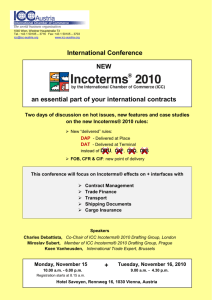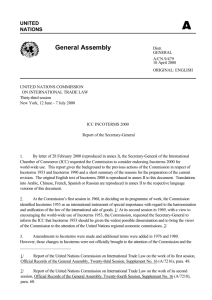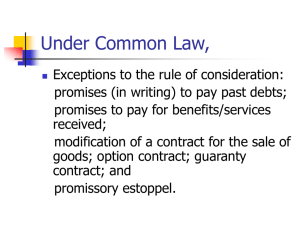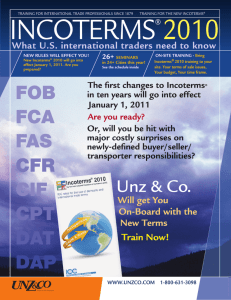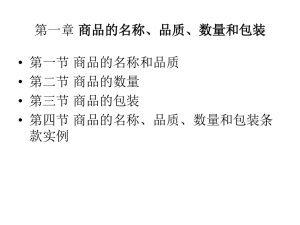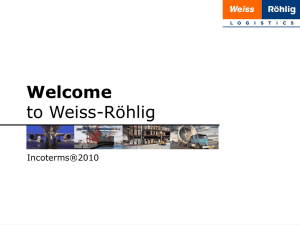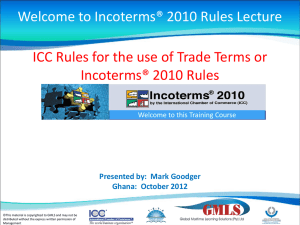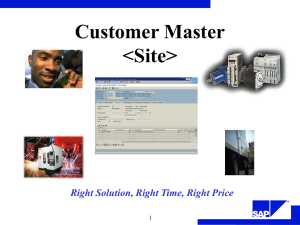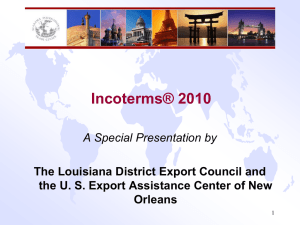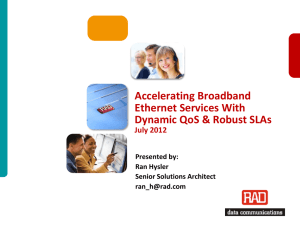supply chain
advertisement
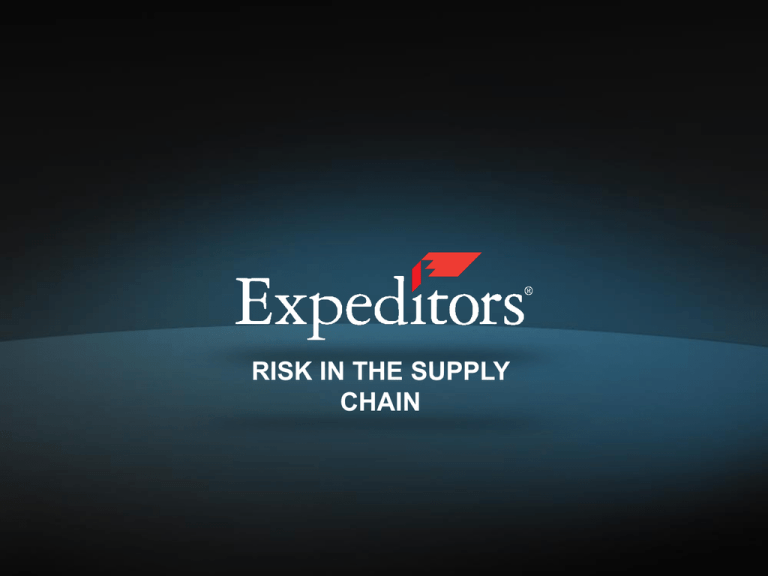
RISK IN THE SUPPLY CHAIN 2 © 2010 3 © 2010 4 © 2010 5 © 2010 6 © 2010 7 © 2010 8 © 2010 9 © 2010 Supply Chain Threats Abound – Security & Political Risk © Control Risks, 2010 Source: www.riskmap-controlrisks.com 10 © 2010 Expeditors International of Washington, Inc. Supply Chain Threats Abound – Corruption / Bribery 11 © 2010 Expeditors International of Washington, Inc. Supply Chain Threats Abound – Cargo Theft Courtesy: © Freightwatch International, 2010 12 © 2010 Expeditors International of Washington, Inc. Supply Chain Threats Abound – Cyclones / Hurricanes 13 © 2010 Expeditors International of Washington, Inc. 14 © 2010 Expeditors International of Washington, Inc. Risk Management – A Conscious Choice Each organization must determine its own appetite for risk. Risk Assessment – Companies gather internal and external intelligence about their supply chains and the threat environment in order to make well-informed risk choices for the enterprise. Risk Avoidance – Companies may change business practices (e.g., by changing sourcing locations) to avoid a high risk practice or area. Risk Acceptance – Companies may decide to accept or ‘self-insure for’ the risk. Doing nothing means accepting the risk. Risk management implies doing so knowingly, after reviewing intelligence about the threats. Risk Control – Companies may choose to manage a risk by putting controls in place either to reduce the likelihood that the risk will materialize or to reduce the impact on the business should an event occur. Risk Transfer -- Companies may transfer risks to insurance markets. Such transfers may work in tandem with a risk control strategy. Certain risks, such as damage to reputation, are inherently uninsurable. 15 © 2010 Expeditors International of Washington, Inc. Supply Chain Threats Global Economy Laws and Regulations Political Unrest Cargo Theft & Smuggling Terrorism Natural Disasters 16 © 2010 Expeditors International of Washington, Inc. Labor Disruptions Supply Chain Attack Security Programs Robust, Comprehensive, Documented Personnel Security Incident Reporting & Analysis Information Security Service Provider Management Access Control Physical Security / Systems Training & Awareness 17 © 2010 Expeditors International of Washington, Inc. Measure, Audit Ownership Enhanced Security Goods In Transit Enhanced Security Solutions Security Escorts Packaging Team Drivers Tracking & Tracing GPS, Geo-Fencing Communication Tamper-Evident Technology & Deterrents Insurance!! 18 © 2010 Expeditors International of Washington, Inc. Supply Chain Protection Security Programs Government, Industry, Partnerships C-TPAT BASC & TAPA FAST TSA - IACSSP, CCSP PIP AEO 19 © 2010 Expeditors International of Washington, Inc. OSHA More Information • U.S. Department of Homeland Security (DHS) and Customs & Border Protection (CBP) • U.S.: Customs-Trade Partnership Against Terrorism (C-TPAT), Free and Secure Trade (FAST) • Canada: Partners in Protection (PIP) • European Union: Authorized Economic Operator (AEO) • Latin America: Business Alliance for Secure Commerce (BASC) • TAPA: Transported Asset Protection Association • US: Transportation Security Administration, IACSSP • US: OSHA (Business Continuity & Emergency Preparedness) 20 © 2010 Expeditors International of Washington, Inc. SUPPLY CHAIN Incoterms ® • Incoterms ® = INternational COmmercial TERMS • First Developed by the International Chamber of Commerce (located in Paris) in 1936 and revised in 1953, 1967, 1976, 1980, 1990, 2000 & 2010 • INCOTERMS ® are available in their full form through the ICC's publication, "INCOTERMS ® 2010". • The purpose of Incoterms ® is to provide a set of international rules for the interpretation of the most commonly used trade terms in foreign trade. COST RISK - OBLIGATION • Terms of sale International business vs domestic (UCC) 22 © 2010 What Incoterms ® 2010 are not • LAW. They must be specified the contract (sales order, purchase order) in order to apply • They do not address passage of title or recognition of revenue • They are not credit terms • Do not protect a party from risk of loss • Define the remedies for breach of contract • Address more than one contract (drop shipments) 23 © 2010 How to use Incoterms correctly • All Incoterms® must accompany a named place – the more specific the better • Ensure both parties are using the correct version of Incoterms 24 © 2010 Named place (on seller’s side) • EXW • FCA 26 © 2010 Named place (on the buyers side) • • • • • 28 CPT CIP DAT DAP DDP © 2010 Marine only FAS FOB CFR CIF 33 © 2010 Incoterms ® 2010 Information gathered from International Chamber of Commerce and available in full form in the Incoterms Chamber of Commerce Incoterms 2010 iccbooksusa.com www.iccwbo.org/incoterms 38 © 2010 Accidents happen…. 39 © 2010 Is your freight on the water or in the water? 41 © 2010 43 © 2010 When are Ocean Carriers NOT Liable? Neither the carrier or ship owner will be responsible for loss or damage arising or resulting from: 1. Act, neglect, or default of the master, mariner, pilot, or the servants of the carrier in the navigation or in the management of the ship. 2. Fire, unless caused by the actual fault or privity of the carrier. 3. Perils, danger, and accidents of the sea or of other navigable waters. 4. Act of God. 5. Act of war. 6. Act of public enemies. 7. Arrest or restraint of princes, rulers or people, or seizure under legal process. 8. Quarantine restrictions. 9. Act or omission of the shipper or owner of the goods, his agent or representative. 10. Strikers or lockouts or stoppage or restraint of labor from whatever cause, whether partial or general; Provided that nothing herein contained shall be construed to relieve a carrier from responsibility for the carrier's own acts 11. Riots and civil commotion's. 12. Saving or attempting to save life or property at sea. 13. Wastage in bulk or weight or any other loss or damage arising from inherent defect, quality, or vice of the goods. 14. Insufficiency of packing. 15. Insufficiency or inadequacy of marks. 16. Latent defects not discoverable by due diligence. 17. Any other cause arising without the actual fault and privity of the carrier without the fault or neglect of the agents or servants of the carrier, but the burden of proof shall be on the person claiming the benefit of this exception to show that neither the actual fault or privity of the carrier nor the fault or neglect of the agents or servants of the carrier contributed to the loss or damage. 44 © 2010 Now what if this happens…. 45 © 2010 47 © 2010 Pacific Coast Hwy, CA. Loss in Excess of US$800,000 49 © 2010 What about Warehouse Liability? 52 © 2010 Be prepared for the unexpected! 54 © 2010 What Protects Me From Carrier’s Liability? • Carriers Liability is very limited and you must prove carrier was at fault • Protect yourself with All-Risk Cargo Insurance 55 © 2010 CLAIMS MANAGEMENT • What is my appetite for risk? Deductible…. • Who purchases insurance / their decisions…. • Which departments are involved? • How is it being signed for? • Why is damage happening? Trends 56 <<< Title | Company Info | Supply Chain | Products and Services | Management | Conclusion | >>> © 2007 Q&A Kerri Sykes Regional Risk & Insurance Manager Expeditors International – North Central Phone: (734) 857-5047 E-mail: kerri.sykes@expeditors.com 59 © 2010 © 2010 Expeditors International of Washington, Inc. All information contained herein is business confidential and proprietary and may not be reproduced in any form without advance written consent of an authorized officer of the copyright holder.

